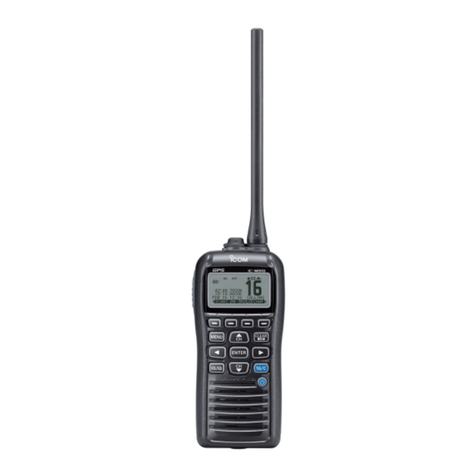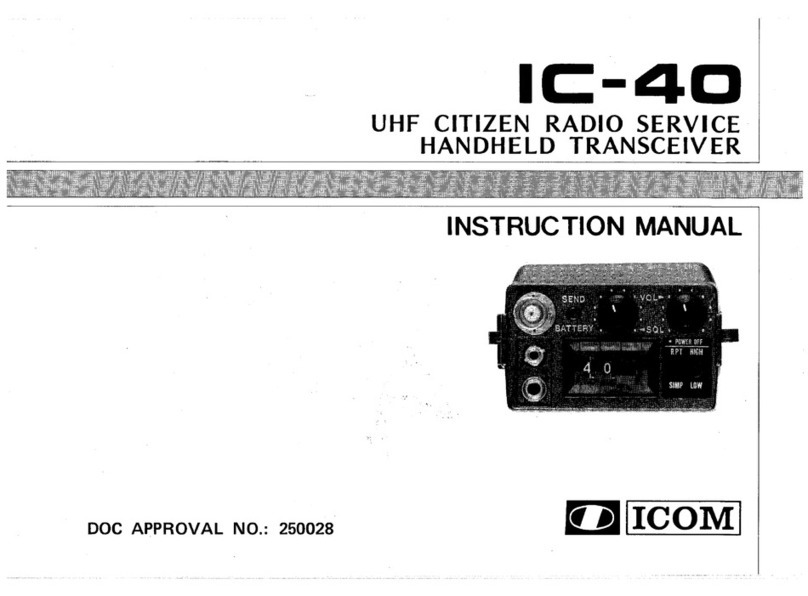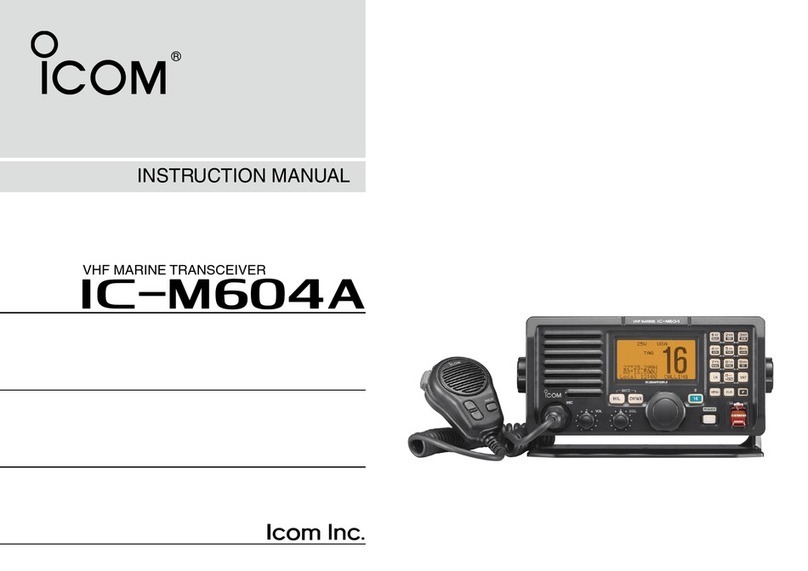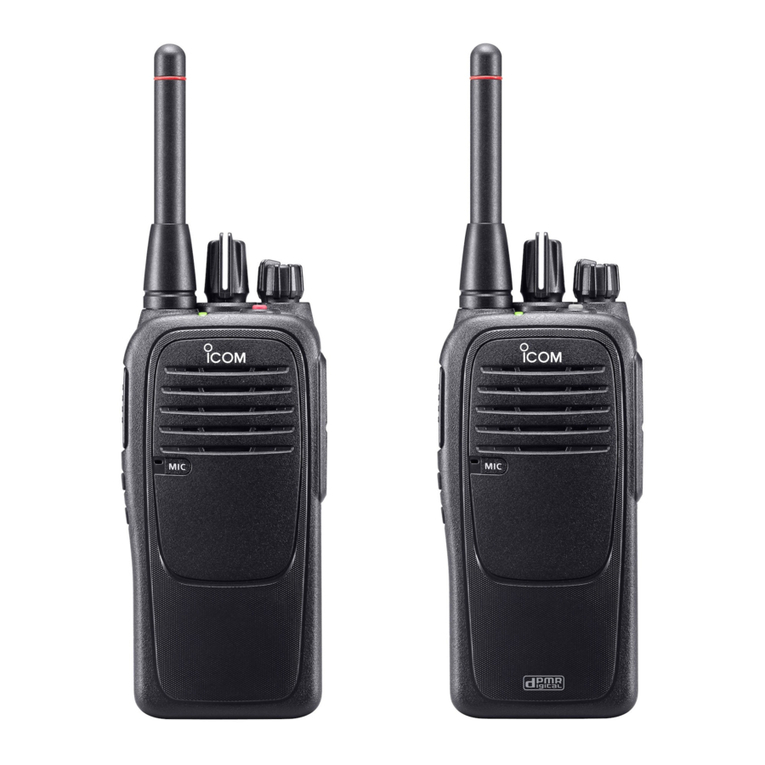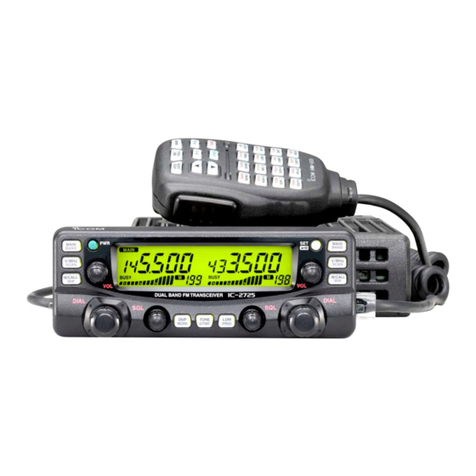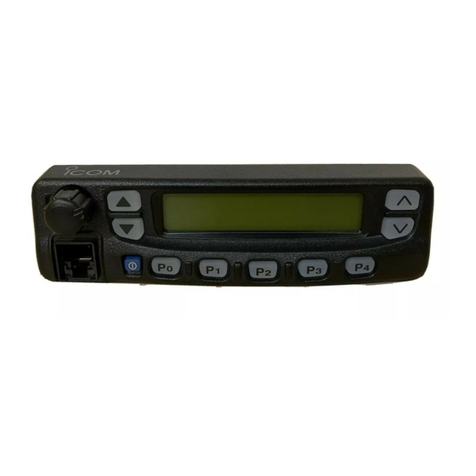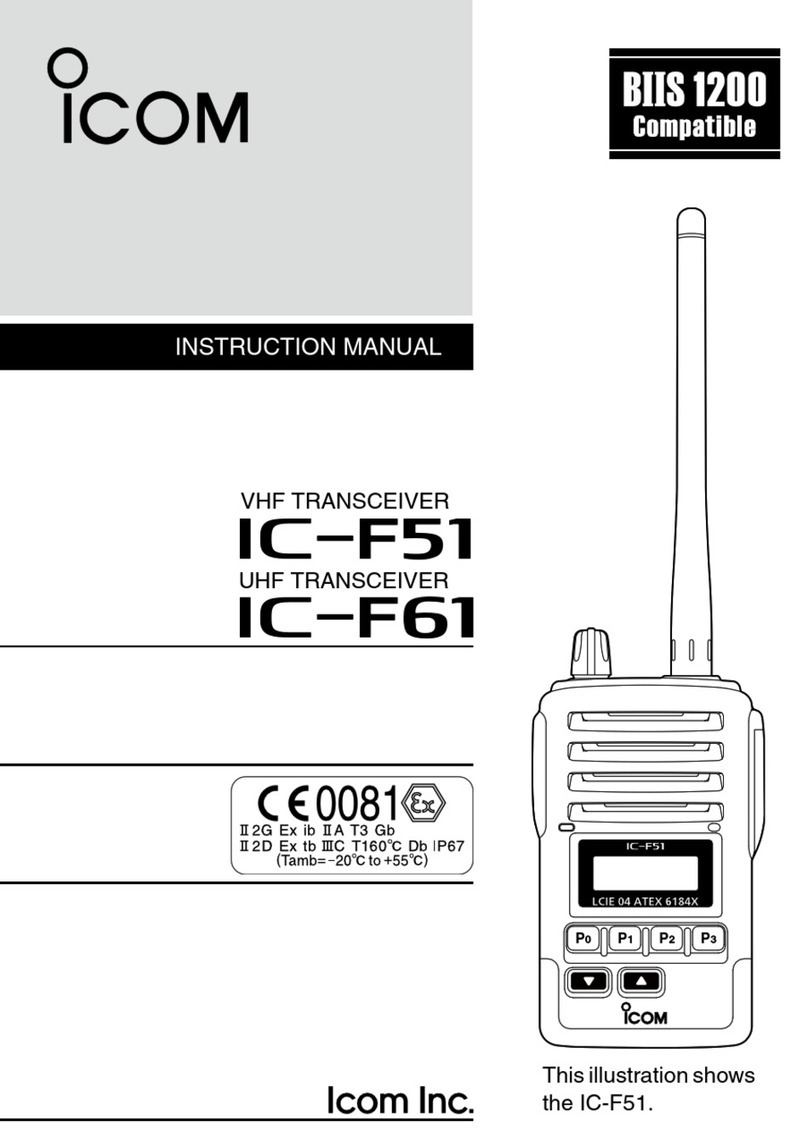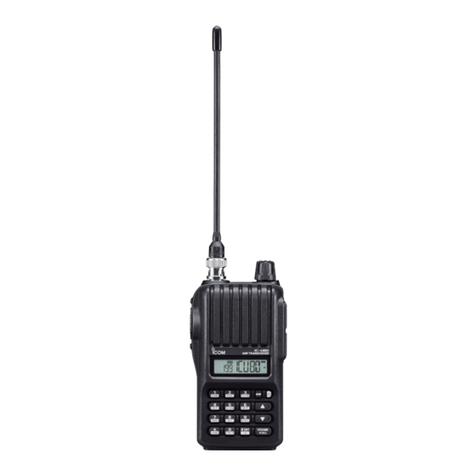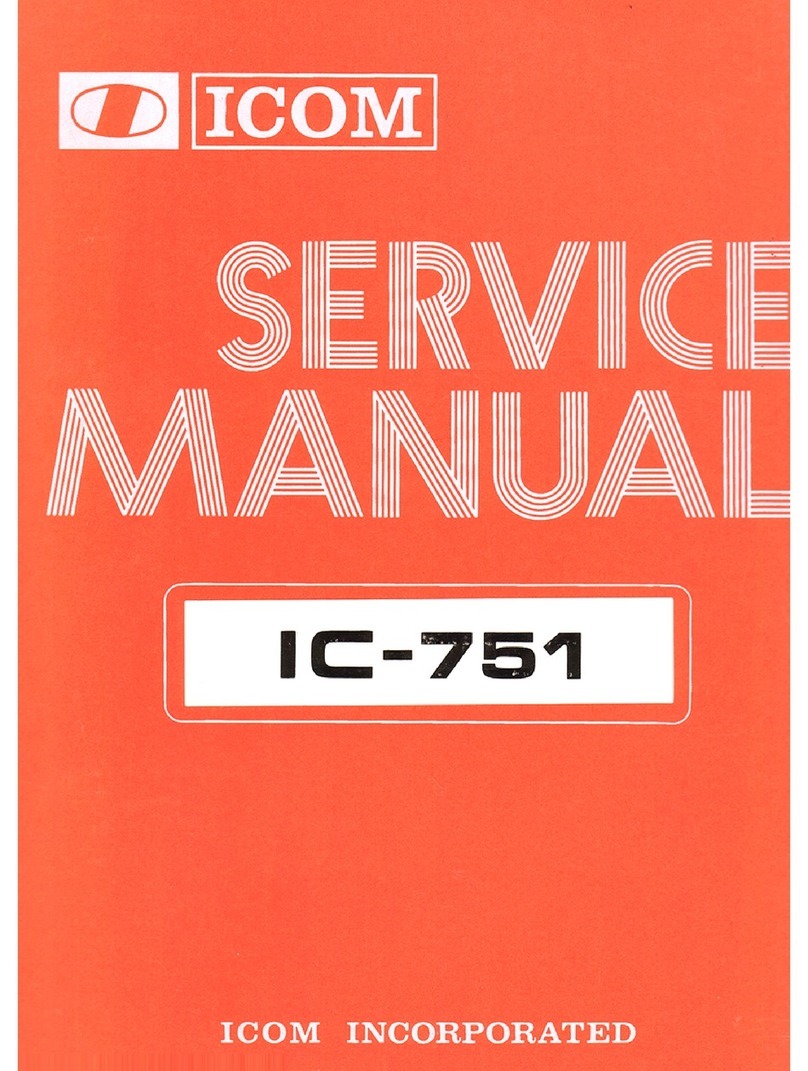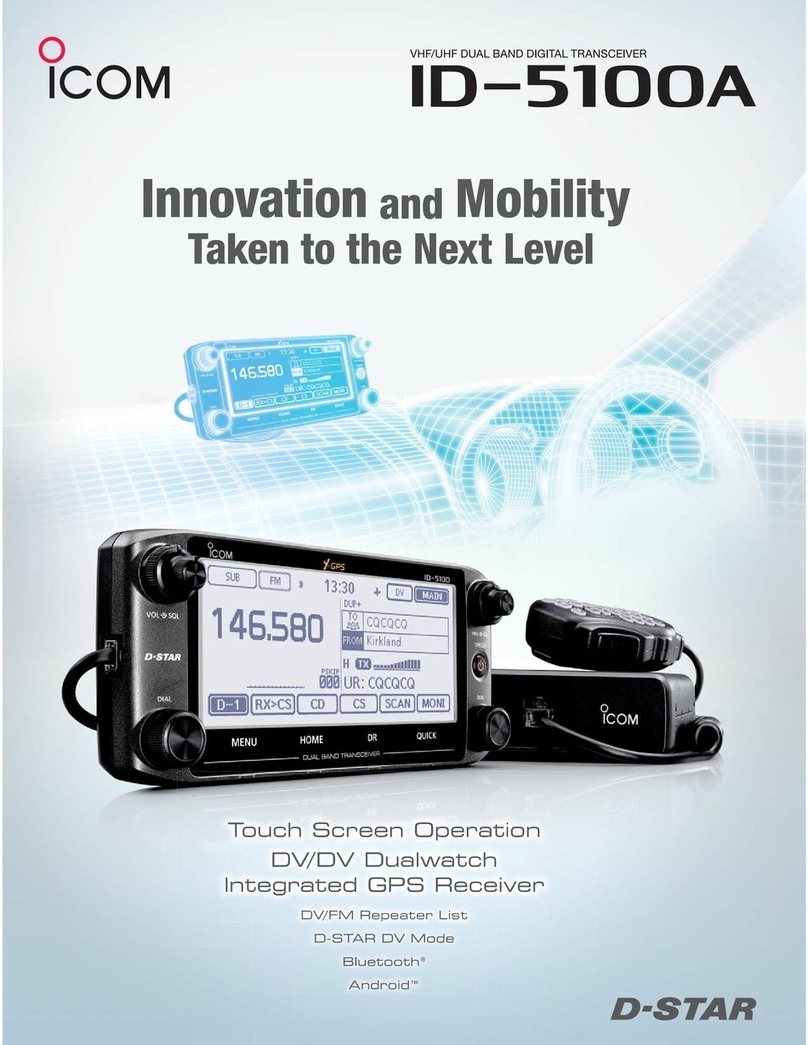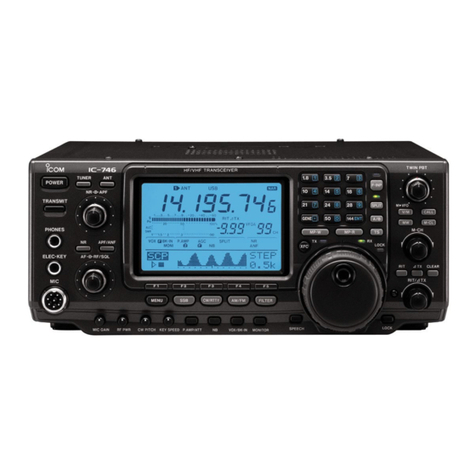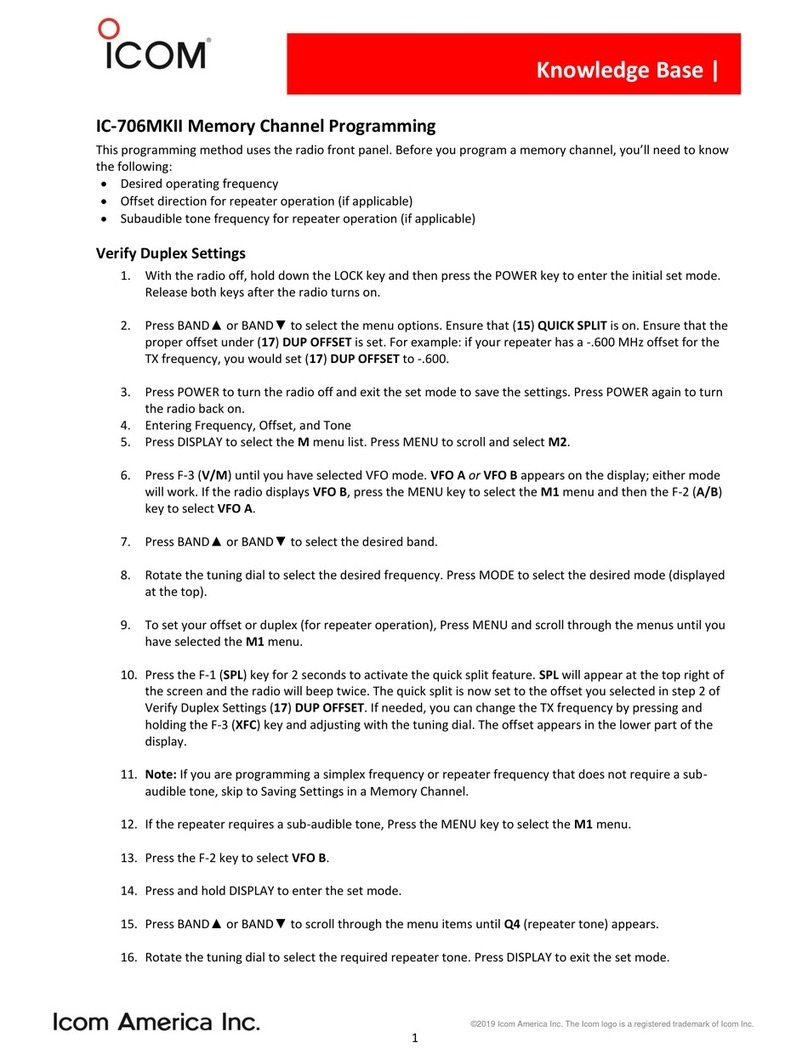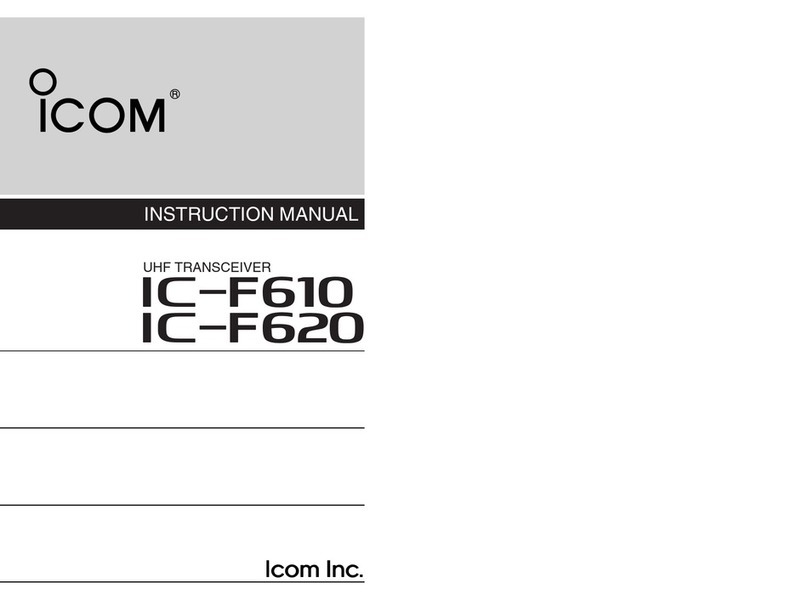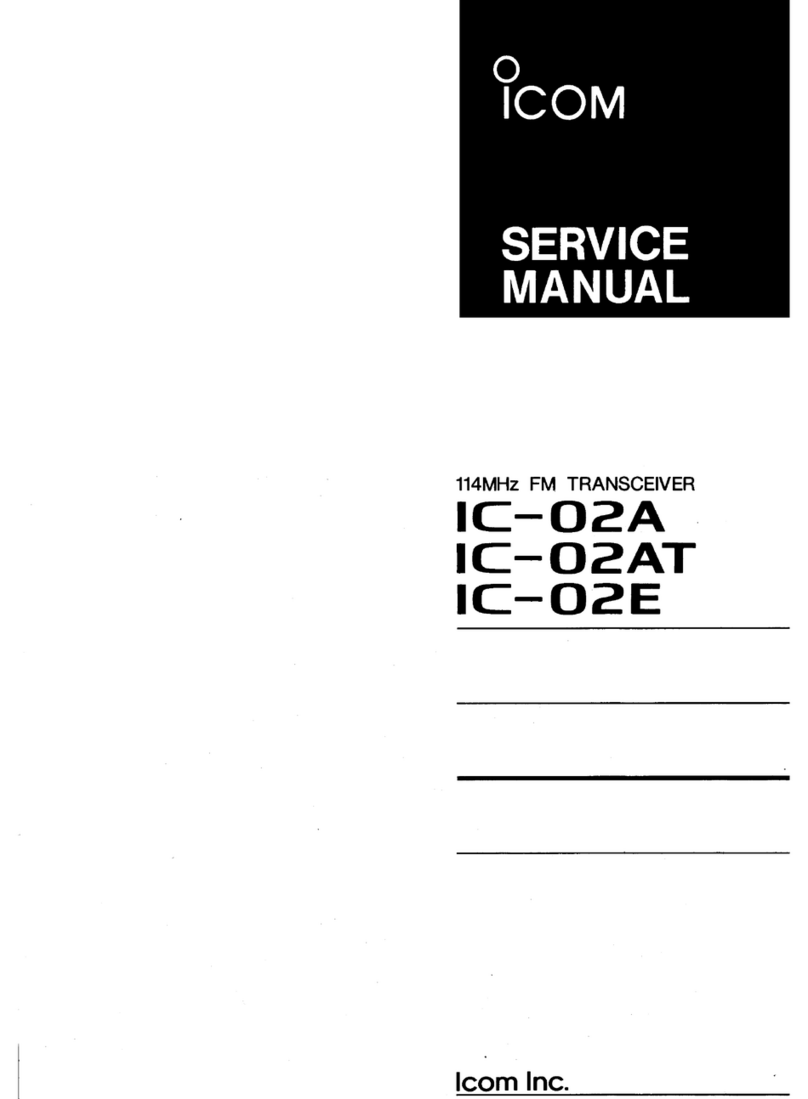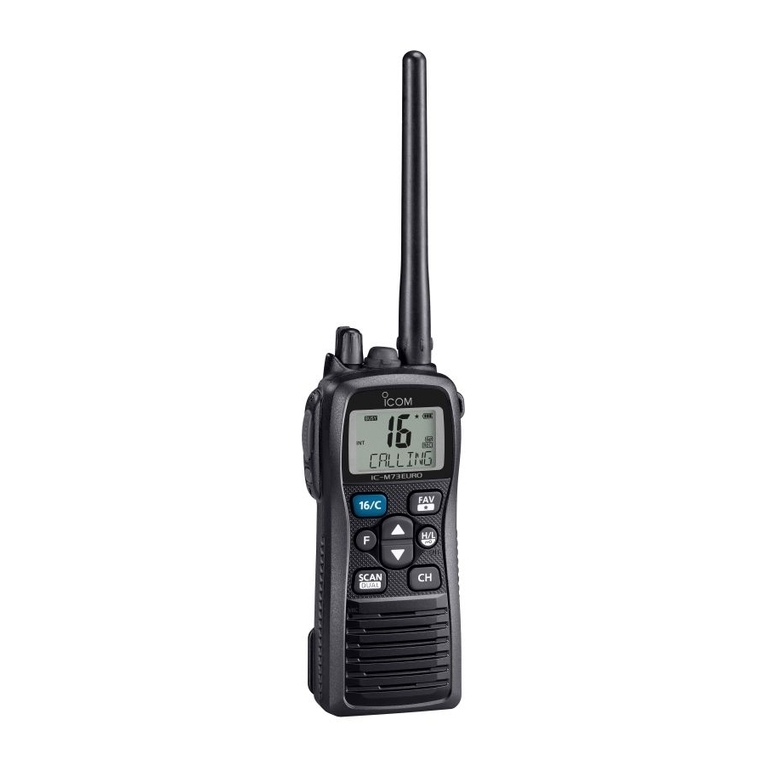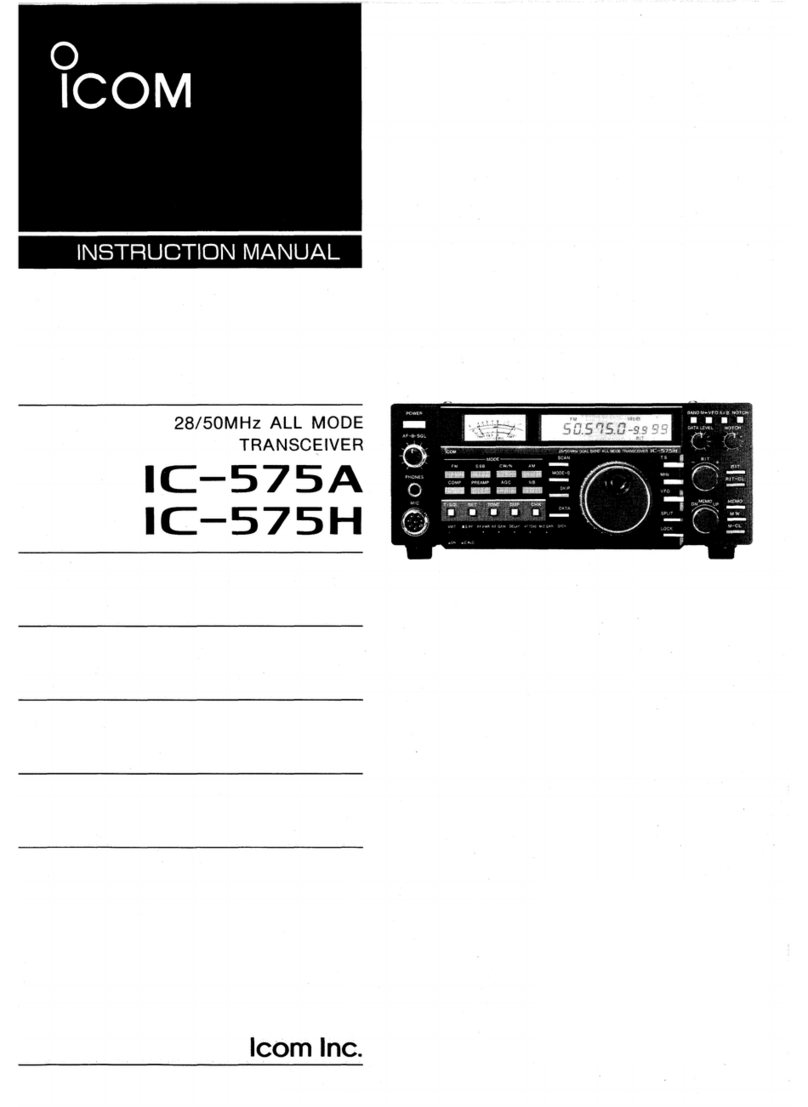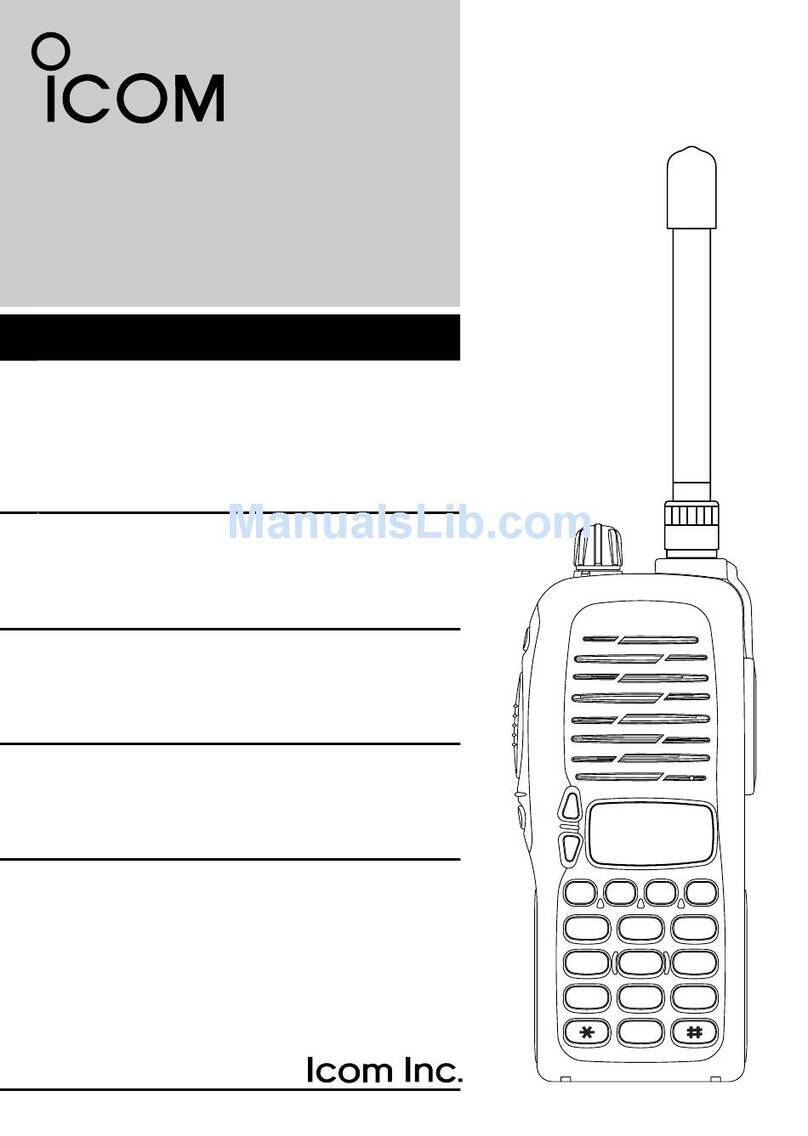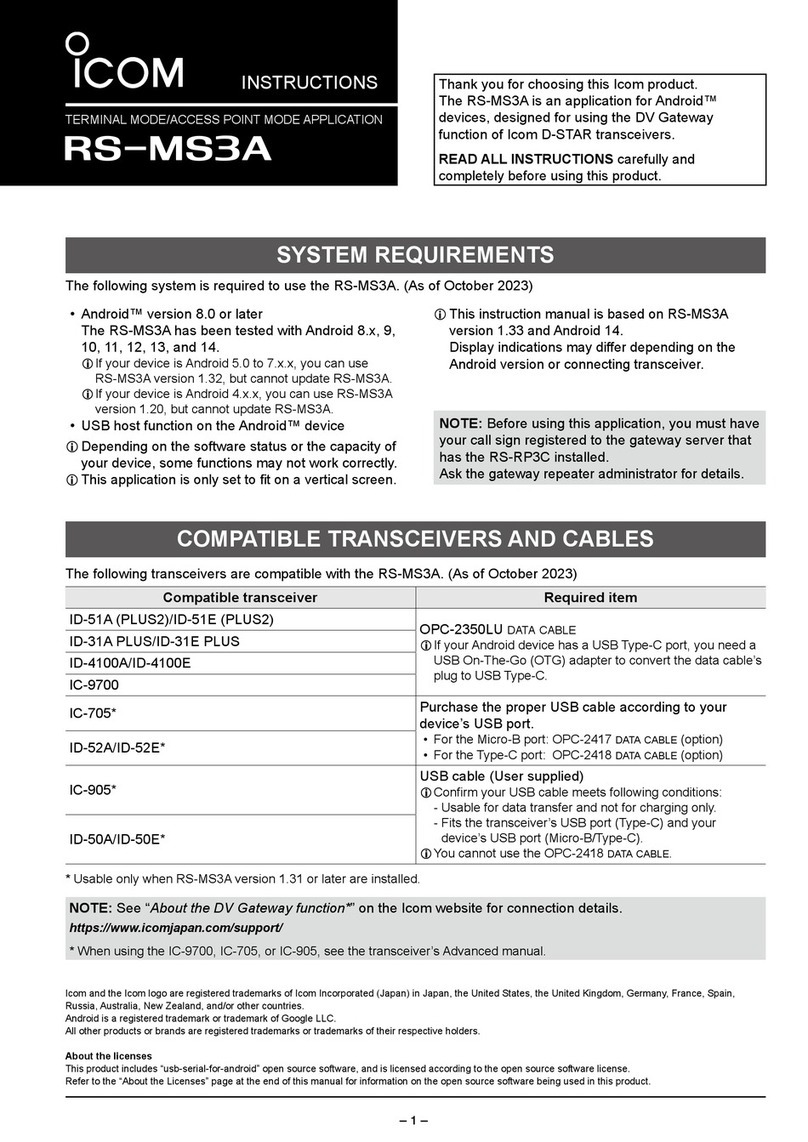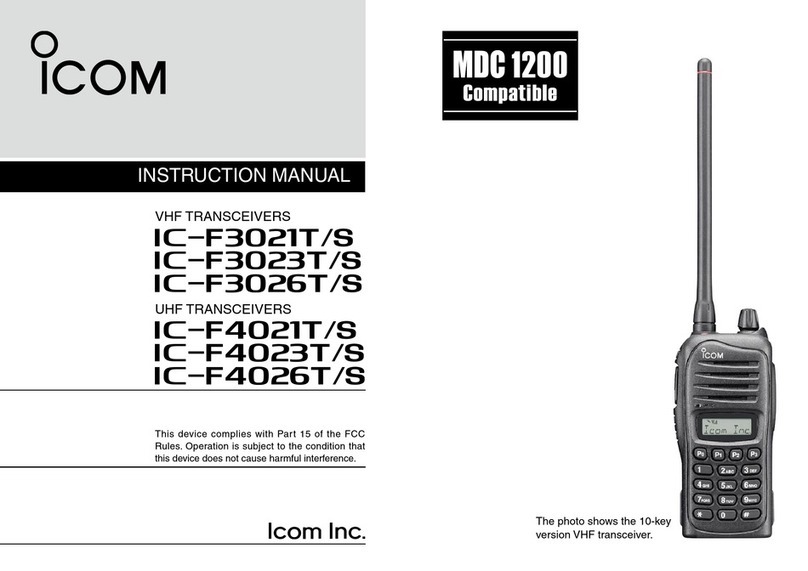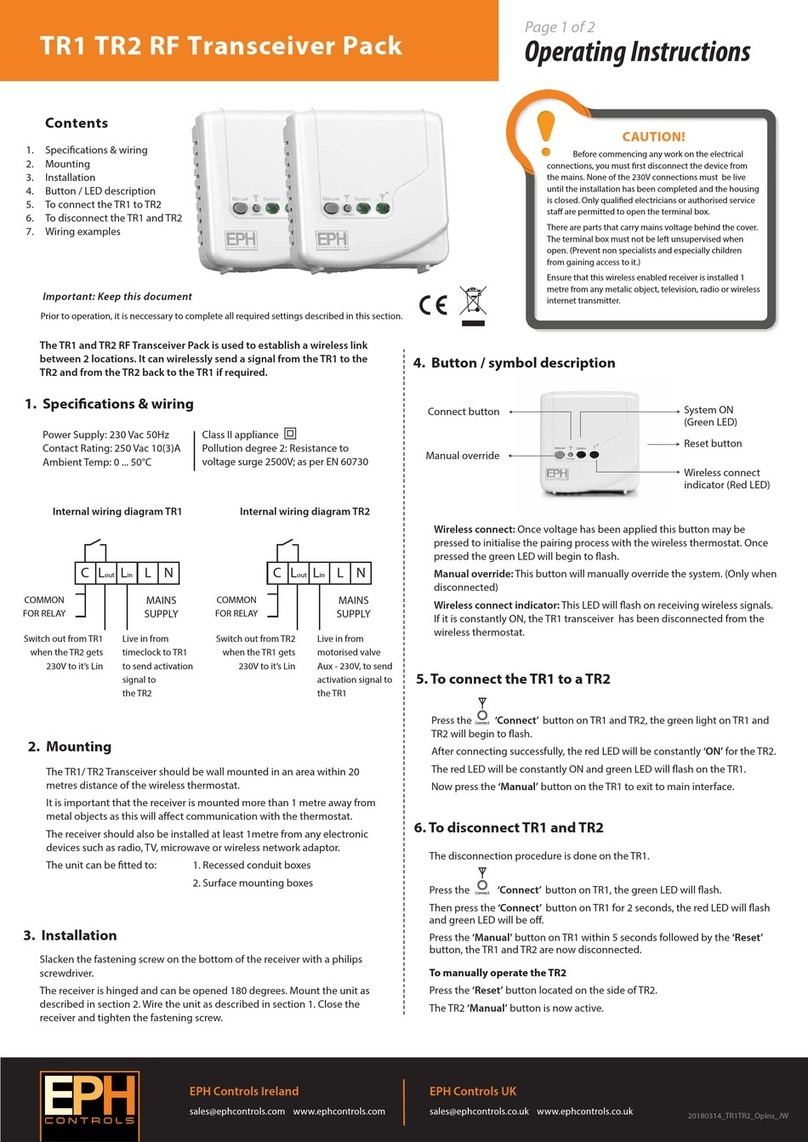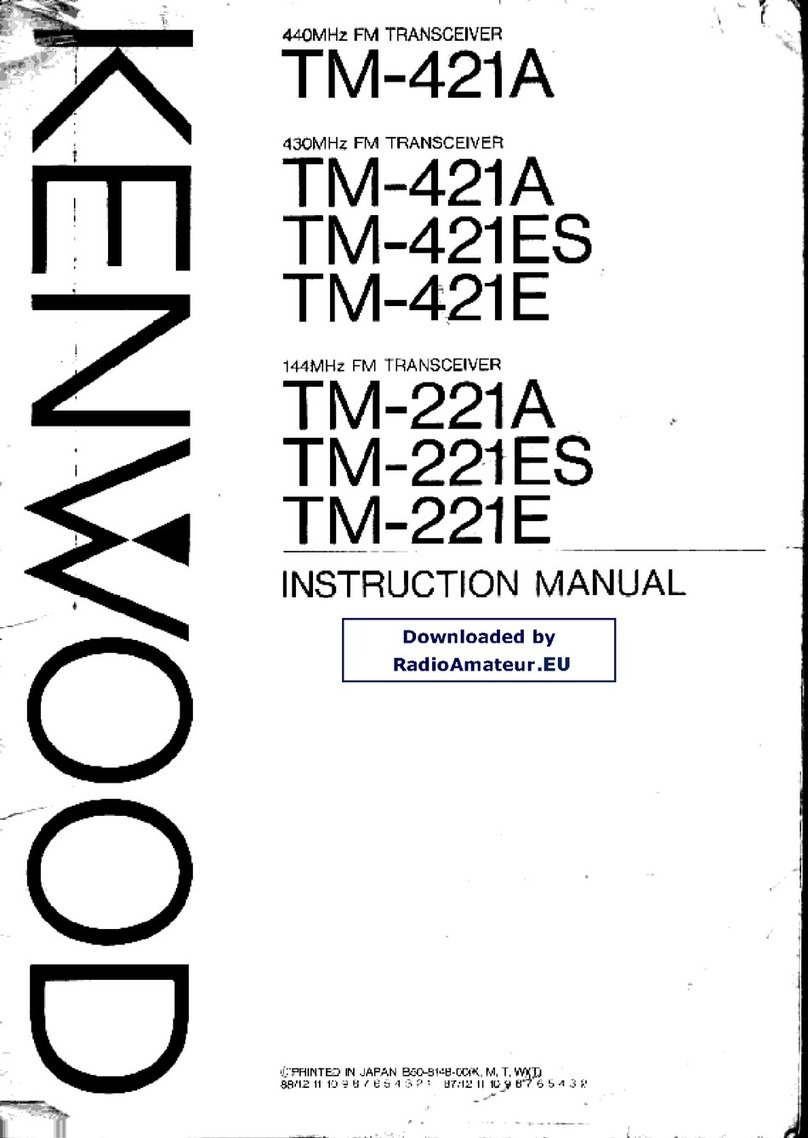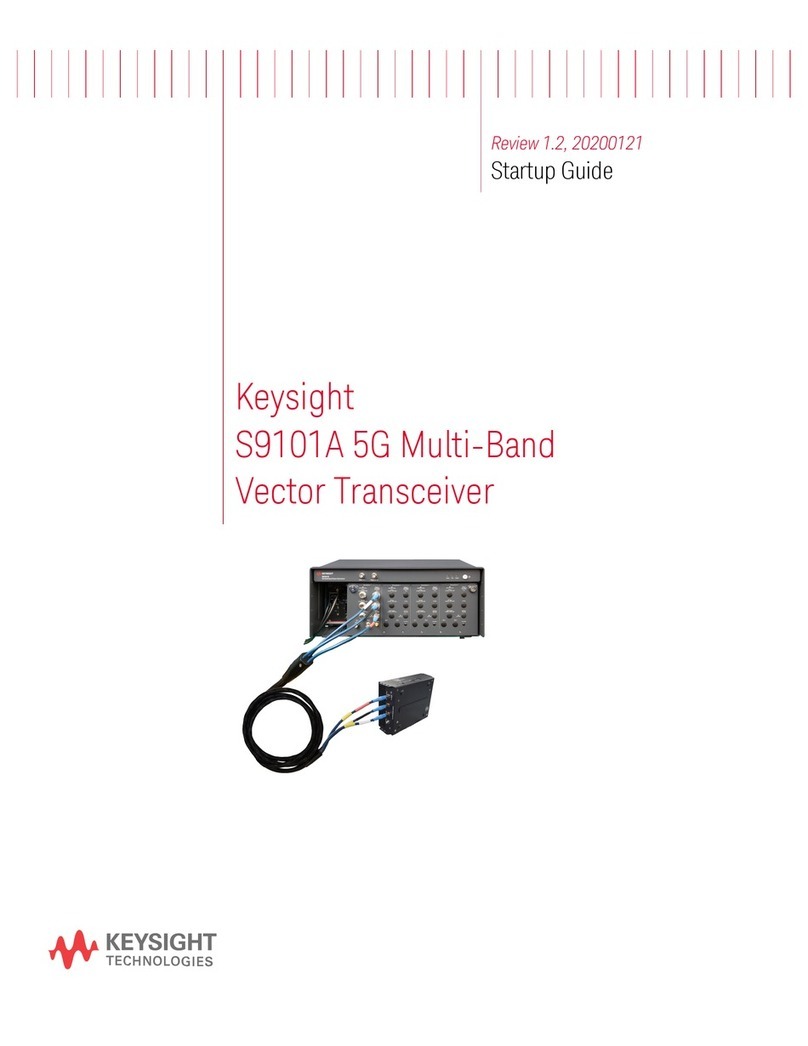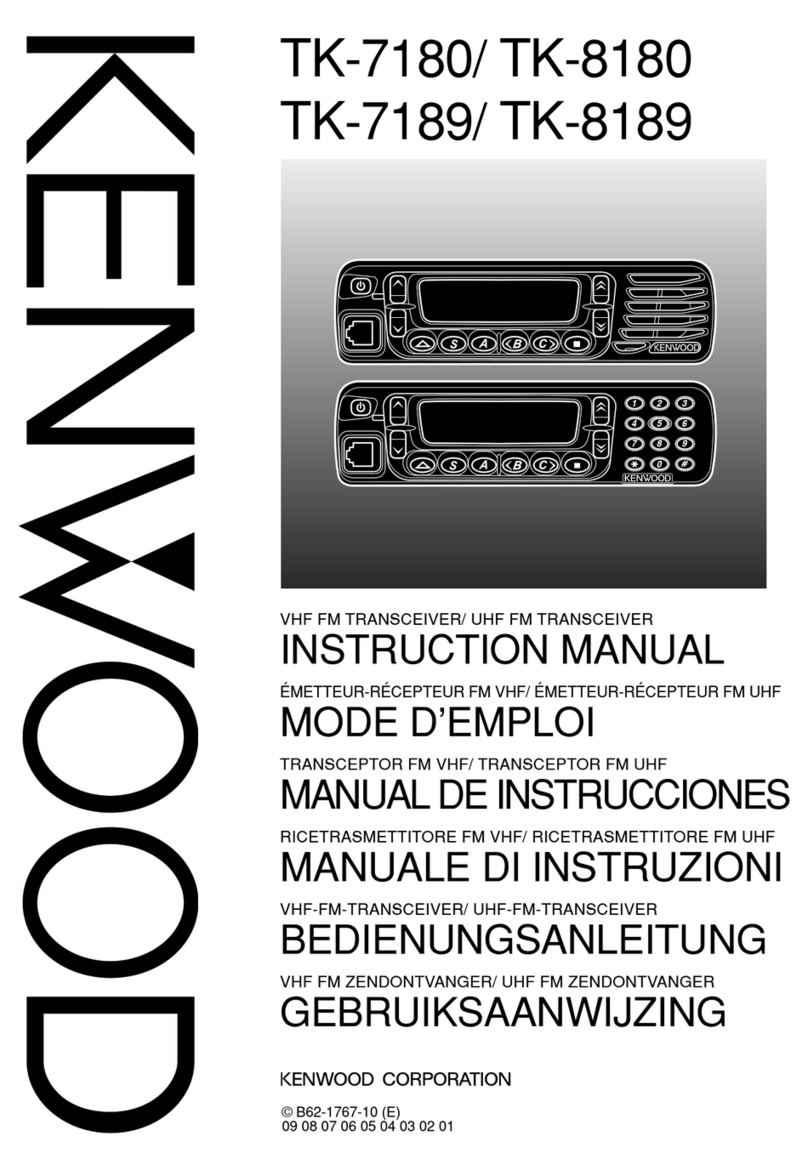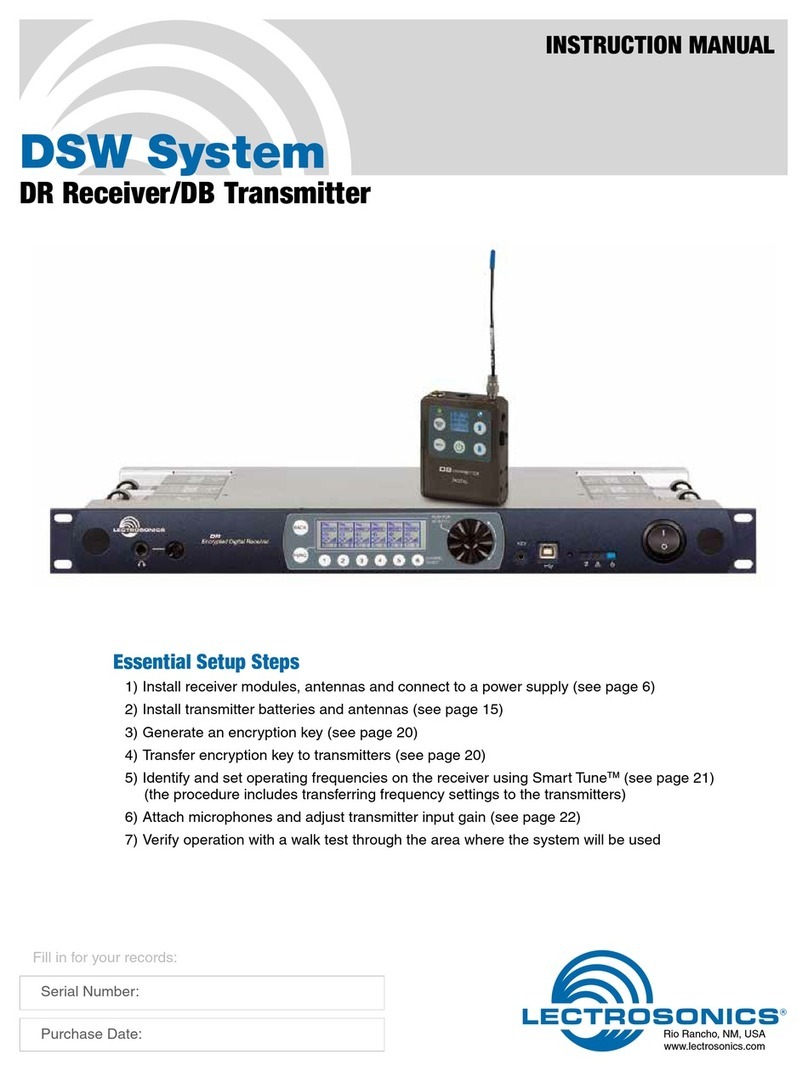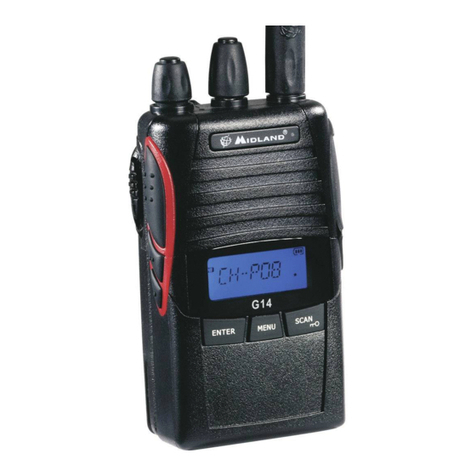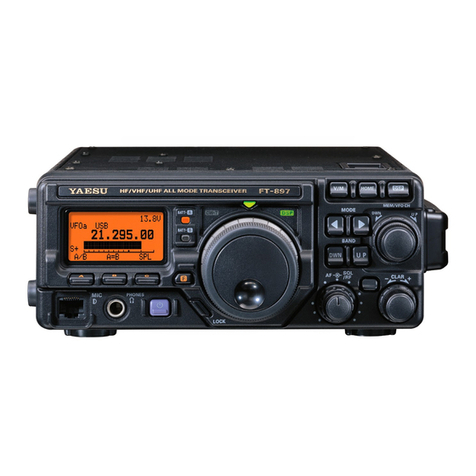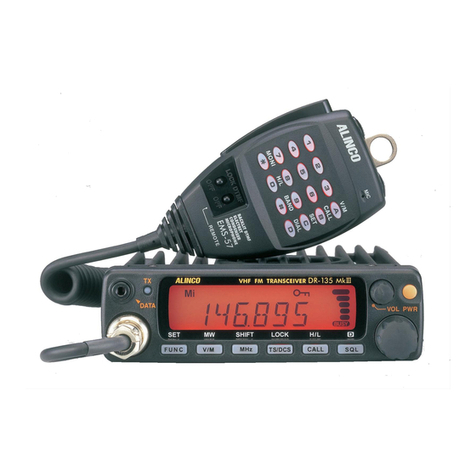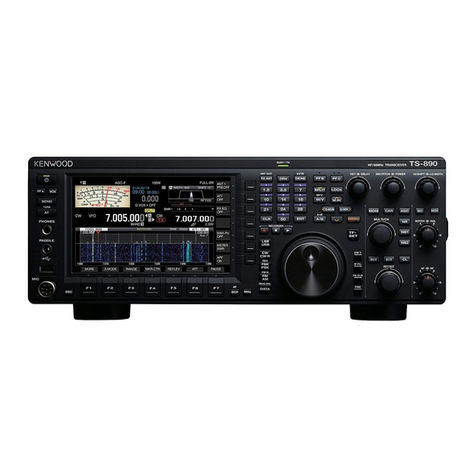Icom IC-M127 User manual

VHF
MARINE
TRANSCEIVER
C-M127
Icom
Inc.

IN
CASE
OF
EMERGENCY
If
your
vessel
requires
assistance,
contact
other
vessels
and
Or,
transmit
your
distress
call
using
digital
selective
calling
on
the
Coast
Guard
by
sending
a
distress
call
on
channel
16.
channel
70
(the
optional
UX-130
psc
unit
must
be
installed),

TABLE
OF
CONTENTS
IN
CASE
OF
EMERGENCY
TABLE
OF
CONTENTS
IMPORTANT
CAUTIONS...
1
OPERATING
RULES
..
2
PANEL
DESCRIPTION
@
Front
panel
....
Function
display
BASIC
OPERATION
@
Receiving
@
Transmitting
@
Scan
function
Call
channel
programming
..
Display
backlighting
Channel
names
DIGITAL
SELECTIVE
CALLING
@
General
.....
@
Distress
call
transmission
All
ships
call
transmission
Individual
call
transmission
@
Address
input
mode
..
lM
Receiving
DSC
calls
5
OTHER
FUNCTIONS
i
Hailer
operation
>
1
Intercom
operation
‘Automatic
fog
horn
@
Internal
speaker
ON/OFF
'§
Displaying
position
6
SET
MODE
........
26-30
Entering
SET
mode
..
SET
mode
items
...
CONNECTIONS
AND
MAINTENANCE
@
Unpacking
..
@
Additional
requirements
x
8
OPTION
INSTALLATION
......
'@
Removing/replacing
the
cas
@
Unit
installation
...
9
TROUBLESHOOTING
...........
10
VHF
MARINE
CHANNEL
LIST
11
SPECIFICATIONS
12
OPTIONS

IMPORTANT
READ
ALL
INSTRUCTIONS
carefully
and
completely
before
using
the
transceiver.
SAVE
THIS
INSTRUCTION
MANUAL—This
instruction
manual
contains
important
operating
instructions
for
the
IC-M127.
YOU
MUST
HAVE
a
DSC
vessel
ID
in
order
to
operate
the
optional
DSC
functions
of
the
transceiver.
See
your
Dealer
for
details.
CAUTIONS
ZAXWARNING
NEVER
connect
the
transceiver
to
an
AC
outlet.
This
may
pose
a
fire
hazard
or
result
in
an
electric
shock.
A\WARNING
HIGH
VOLTAGE!
NEVER
touch
the
antenna
or
an
internal
antenna
connector
during
trans-
mission.
This
may
result
in
an
electric
shock
or
a
burn,
NEVER
connect
the
transceiver
to
a
power
source
of
more
than
16
V
DC.
This
connection
will
ruin
the
transceiver.
WHEN
INSTALLING
THE
DSC
UNIT
NEVER
transmit
a
distress
call
when
your
vessel
does
not
need
immediate
help.
Distress
calls
can
be
used
only
in
times
of
emergency.
AVOID
using
or
placing
the
transceiver
in
direct
sunlight
or
in
areas
with
temperatures
below
—20°C
(-4°F)
or
above
+60°C
(+140°F).
DO
NOT
operate
the
transceiver
without
running
the
ves-
sel's
engine.
When
your
vessel's
engine
is
OFF
and
the
trans-
ceiver
is
transmitting,
the
vessel's
battery
will
soon
become
exhausted.
KEEP
the
transceiver
out
of
the
reach
of
children.
KEEP
the
transceiver
and
microphone
at
least
1
meter
away
from
your
vessel's
magnetic
navigation
compass.

©
Priorities
*
Read
all
rules
and
regulations
pertaining
to
priorities
and
keep
an
up-to-date
copy
handy. Safety
and
distress
calls
take
priority
over
all
others.
*
You
must
monitor
channel
16
when
you
are
not
operating
on
another
channel.
*
False
or
fraudulent
distress
calls
are
prohibited
under
law.
©
Privacy
*
Information
overheard
but
not
intended
for
you
cannot
law-
fully
be
used
in
any
way.
*
Indecent
or
profane
language
is
prohibited.
©
Radio
licenses
SHIP
STATION
LICENSE
You
must
have
a
current
radio
station
license
before
using
the
transceiver.
It
is
unlawful
to
operate
a
ship
station
which
is
not
licensed.
Inquire
through
your
dealer
or
the
appropriate
government
agency
for
a
Ship-Radiotelephone
license.
This
license
in-
cludes
the
call
sign
which
is
your
craft's
identification
for
radio
purposes.
OPERATING
RULES
An
FCC
form
506
may
be
supplied
with
the
IC-M127
U.S.A.
version.
In
this
case,
complete
the
form
and
send
it
to
the
nearest
FCC
office.
OPERATOR'S
LICENSE
A
restricted
Radiotelephone
Operator
Permit
is
the
license
most
often
held
by
small
vessel
radio
operators
when
a
radio
is
not
required
for
safety
purposes.
The
Restricted
Radiotelephone
Operator
Permit
must
be
posted
near
the
transceiver
or
be
kept
with
the
operator.
Only
a
licensed
radio
operator
may
operate
a
transceiver.
However,
non-licensed
individuals
may
talk
over
a
transceiver
if
a
licensed
operator
starts,
supervises,
ends
the
call
and
makes
the
necessary
log
entries.
A
current
copy
of
the
applicable
government
rules
and
regu-
lations
is
only
required
to
be
on
hand
for
vessels
in
which
a
radio
telephone
is
compulsory.
However,
even
if
you
are
not
required
to
have
these
on
hand
it
is
your
responsibility
to
be
thoroughly
acquainted
with
all
pertinent
rules
and
regulations.
1

—P
i
|
PANEL
DESCRIPTION
@
Front
panel
Function
display
(p.
4)
Speaker
@
CHANNEL
SELECTOR
[CHANNEL]
Selects
an
operating
channel
in
the
selected
channel
group,
@
CHANNEL
16
SWITCH
[16
*
POS]
*
Selects
channel
16.
(p.
6)
Push
for
1
sec.
to
display
your
position
(when
a
GPS
re-
ceiver
is
connected).
(p.
25)
©
CALL
CHANNEL
SWITCH
[9
*
SCRM]
*
Selects
the
call
channel—the
call
channel
is
program-
mable,
channel
9
being
the
default.
(p.
6)
*
Push
and
hold
to
activate
the
optional
voice
scrambler
function
(optional
UT-98
is
required).
(pgs.
38,
43)
@
CHANNEL/WEATHER
CHANNEL
SWITCH
[CH/WX
+
unc]
*
Toggles
between
regular
and
weather
channels.
(p.
7)
*
Selects
channel
groups
in
sequence
when
pushed
for
1
sec.
(p.
7)
©
DUALTRI-WATCH
SWITCH
[DUAL
*
TRI]
(p.
8)
*
Activates
dualwatch
for
checking
channel
16.
*
Push
for
1
sec.
to
activate
tri-watch
for
checking
channel
16
and
the
call
channel.
@
SCAN
SWITCH
[SCAN
«
TAG]
*
Starts
and
stops
normal
or
priority
scan
when
tag
chan-
nels
are
programmed.
(p.
10)

*
Push
for
1
sec.
to
toggle
the
tag
setting
for
the
displayed
channel.
(p.
10)
@
HIGH/LOW
POWER
SWITCH
[HI/LO
«
DIM]
*
Toggles
between
high
and
low
output
powers.
(p.
9)
*While
pushing,
rotate
the
channel
selector
or
push
the
[V/A]
switches
on
the
microphone
to
adjust
the
display
and
control/switch
backlighting
intensity.
(p.
11)
©
SQUELCH
CONTROL
[SQUELCH]
*
Rotate
clockwise
to
eliminate
audio
noise.
(p.
8)
*
Activates
the
built-in
attenuator
when
rotated
deep
clock-
wise.
(p.8)
@
POWER/VOLUME
CONTROL
[PWR/VOL]
(p.
8)
*
Push
to
turn
power
ON/OFF.
*
Rotate
to
adjust
the
audio
output.
@
HAILER/INTERCOM
SWITCH
[HLIIC
«
A.FOG]
*Selects/turns
OFF
the
hailer
and
intercom
functions,
(pgs.
21,
22)
*
Push
for
5
sec.
to
activate
the
auto
fog
horn
function.
(p.
24)
@
INDIVIDUAL
CALL
SWITCH
[INDV]
(p.
16)
Push
for
5
sec.
to
enter
the
individual
call
standby
condi-
tion
(when
optional
UX-130
is
installed).
@
EMERGENCY
SWITCH
[EMER]
(p.
14)
Push
for
5
sec.
to
enter
the
distress
call
transmission
standby
condition
(when
optional
UX-130
is
installed).
PANEL
DESCRIPTION
2
®
CHANNEL
NAME
SWITCH
[NAME]
*
Push
to
enter
name
input
mode.
(p.
12)
*
Push
for
5
sec.
to
enter
the
stand
by
condition
for
an
“all
ships
call"
(when
optional
UX-130
is
installed).
(p.
15)
@
CHANNEL
UP/DOWN
SWITCHES
[VJ/[4]
*
Select
an
operating
channel
in
the
selected
channel
group.
=
These
switches
can
be
used
instead
of
the
transceiver's
channel
selector.
@
HIGH/LOW
POWER
SWITCH
[HI/LO]
The
same
function
as
the
transceiver's
front
panel.
*
Toggles
between
high
and
low
output
powers.
(p.
9)
*
While
pushing,
rotate
the
channel
selector
to
adjust
the
display
and
control/switch
backlighting
intensity.
(p.
11)
|

2
PANEL
DESCRIPTION
@
Function
display
@
MODE
INDICATORS
(p.
7)
‘»
“USA”
shows
USA
channels
are
selected,
‘»
“CAN” shows
Canadian
channels
are
selected.
‘»
“INT”
shows
International
channels
are
selected.
‘»
“WX"
shows
weather
channels
are
selected.
@
CALL
CHANNEL
INDICATOR
Appears
when
the
call
channel
is
selected.
(p.
6)
©
WEATHER
ALERT
INDICATOR
Indicates
the
weather
alert
function
is
activated.
(p.
7)
@
CHANNEL
INDICATOR
Shows
the
operating
channel.
(p.
7)
@
DUPLEX
INDICATOR
Appears
when
the
selected
channel
is
a
duplex
channel.
@
TAG
CHANNEL
INDICATOR
Appears
when
the
selected
channel
is
set
as
a
tag
chan-
nel.
(p.
10)
@
Low
POWER
INDICATOR
Shows
that
low
output
power
is
selected.
(p.
9)

©
LOW
BATTERY
INDICATOR
Appears
when
the
vessel's
battery
voltage
drops
below
11
V.
(p.
6)
@
VOICE
SCRAMBLER
INDICATOR
Appears
while
the
optional
voice
scrambler
is
activated.
(p.
8)
@
SEND
INDICATOR
Appears
when
DSC
information
has
been
transmitted.
(pgs.
13-20)
@
RECEIVE
INDICATOR
Appears
when
DSC
information
has
been
received.
(pgs.
13-20)
@®
TRANSMIT
INDICATOR
Appears
while
transmitting.
(p.
9)
®
AUTO
FOG
HORN
INDICATORS
Appear
when
the
auto
fog
horn
function
is
activated.
The
number
of
indicators
varies
according
to
the
selected
fog
horn
type.
(p.
24)
@®
s/AF
INDICATOR
‘=
Shows
the
relative
signal
strength
while
receiving.
‘»
Shows
whether
high
or
low
output
power
is
selected
while
transmitting.
(pgs.
8,
9)
@
NMEA
INDICATOR
Appears
when
NMEA
devices
(such
as
a
GPS
receiver)
are
connected.
(p.
35)
PANEL
DESCRIPTION
2
@
ALPHANUMERIC
READOUT
‘»
Displays
channel
names
during
regular
operation.
(p.
12)
‘»
Displays
position
and
UTC
time
when
[16
*POS]
is
pushed
for
1
sec.
(p.
25)
‘»
Displays
selected
functions,
DSC
information,
set
mode
items,
etc.
depending
on
operation.
1

o
|
3
@
Power
ON
@
Push
[PWR]
in
to
turn
power
ON.
All
display
indications
appear
briefly’.
BASIC
OPERATION
*SCRM
appears
only
when
an
optional
UT-08
is
installed,
®
Operate
the
transceiver
as
indicated
in
the
following
sec-
tions.
©
Low
voltage
indicator
When
“BATT”
appears
and
flashes
as
shown
at
right,
the
vessel's
bat-
tery
voltage
has
dropped
below
11V,
indicating
there
is
a
DC
power
source
problem,
In
this
case,
check
your
vessel's
bat-
tery
and
DC
power
cable.
@
Channel
selection
©
Channel
16
Channel
16
is
the
distress
channel.
It
is
used
for
establishing
initial
contact
with
another
station
and
for
emergency
com-
munications.
Channel
16
is
monitored
during
dualwatch/tri-
watch.
While
standing
by
you
are
required
to
monitor
channel
16.
-
6
|
©
Call
channel
The
call
channel
is
used
to
store
your
most
often-used
chan-
nel
for
quick
recall.
In
addition,
the
call
channel
is
monitored
during
tri-watch,
The
default
setting
for
the
call
channel
is
channel
9,
which
is
for
pleasure
boat
use.
Push
CG)
rt
ves
Lf
“CALL"
indicates
that
the
call
channel
is
selected.

©
U.S.A.,
Canadian
and
international
channels
There
are
63
U.S.A.,
62
Canadian
and
59
international
chan-
nels.
These
channel
groups
may
be
specified
for
the
operat-
ing
area.
@
Push
[CH/WX]
to
select
a
regular
channel.
If
a
weather
channel
appears,
push
[CH/WX]
again.
®
Rotate
the
channel
selector
to
select
a
channel.
*“DUP”
appears
for
duplex
channels.
@
To
change
the
channel
group,
push
[CH/WX
*
U/I/C]
for
1
sec,
+U.S.A.,
Canadian
and
international
channels
can
be
selected
in
sequence,
U.S.A.
channels
International
channels
Canadian
channels
NOTE:
When
“DUP”
appears
in
the
display
the
se-
lected
channel
is
a
duplex
channel.
Duplex
channels
are
used
for
ship-to-coast
communications.
When
“DUP"
does
not
appear
in
the
display,
the
se-
lected
channel
is
a
simplex
channel.
Simplex
chan-
Z,
nels
are
used
for
ship-to-ship
communications.
YX4489
BASIC
OPERATION
3
©
Weather
channels
There
are
10
weather
channels.
These
are
used
for
monitor-
ing
NOAA
(National
Oceanographic
and
Atmospheric
Administration)
weather
broadcasts.
Push
once
or
twice
wv
CONVENIENT
Weather
alert
function:
NOAA
broadcast
stations
transmit
a
weather
alert
tone
before
important
weather
announcements.
When
the
weather
alert
function
is
turned
ON
(in
SET
mode),
and
the
IC-M127
receives
an
alert
tone,
the
“ALT”
indicator
flashes
until
any
key
is
pushed.
This
function
can
only
be
activated
when
a
weather
channel
is
selected
or
during
any
scan
(if
the
scan
includes
weather
channels).
See
“SET
mode
items”
on
p.
28.
*
|

|
3
BASIC
OPERATION
@
Receiving
@
Push
[PWR]
to
turn
power
ON.
@
Rotate
[SQUELCH]
fully
counterclockwise.
@
Rotate
[VOLUME]
to
obtain
a
suitable
listening
level.
@
Rotate
[SQUELCH]
clockwise
until
the
audio
noise
disap-
pears.
©
Select
the
desired
channel.
See
pgs.
6-7
for
details.
+
When
a
signal
is
received:
+
The
squelch
opens;
Audio
is
emitted
from
the
speaker;
$The
S/RF
indicator
shows
the
re-
ceived
signal
strength.
©
When
an
interrupting
signal
is
received;
rotate
[SQUELCH]
deeply
clockwise.
©
Voice
scrambler
function
For
confidential
communications,
use
the
optional
voice
scrambler
function.
All
members
of
your
group
must
have
the
UT-98
voice
SCRAMBLER
UNIT
installed
in
order
to
communi-
cate
using
this
function,
‘»
Push
[9
*
SCRM]
for
1
sec.
to
tog-
me
gle
the
function
ON
and
OFF.
ose
LY
*“SCRM”
appears
when
the
function
is
ON.
*
This
function
cannot
be
used
on
CH
16.
*
Set
the
scramble
code
in
SET
mode
in
advance
(p.
30).
©
Dual/tri-watch
functions
These
functions
allow
you
to
conveniently
check
the
distress
channel
(ch 16)
or,
both
the
distress
and
call
channel
(ch
9;
programmable)
while
receiving
another
channel.
When
re-
ceiving
a
signal
on
one
of
these
channels,
the
transceiver
stops
on
the
channel
until
the
signal
disappears,
‘»
Push
[DUAL
*
TRI]
momentarily
for
dualwatch,
i)
ft
tow
tow
ies
Nee
“yin
JURA
lb
yarns
+
eee
Checking
channel
16
Signals
on
channel
16
are
every
2
sec.
monitored
until
they
disappear.
‘=
Push
and
hold
[DUAL
*
TRI]
for
tri-watch.
noe
Joaun
Low
eal
Ly.
<n
“IRI
16
Checking
channel
16
and
When
receiving
a
signal
on
the
channel,
the
call
channel
is
monitored
while
checking
ch
16
the
call
channel
every
2
sec.
Signals
received
on
channel
16have
fen
ST
priority.
wil
|
pcm

=
eSSSSSSSSSSSSSSSSSSSSSSmmMSSSsSMMMMMMSMMSSsFse
B
Transmitting
Before
transmitting,
read
the
call
procedures
at
right.
@
Select
an
operating
channel.
See
pgs.
6,
7
for
details.
@
Push
[HI/LO]
to
select
transmit
output
power.
+
“LOW"
appears
when
low
output
power
is
selected.
*
High
power
cannot
be
selected
on
some
channels.
Refer
to
the
channel
list
on
pgs.
40,
41.
©
Push
and
hold
the
PTT
switch
to
transmit.
+"
GE"
appears.
@
Speak
into
the
microphone
at
your
normal
voice
level.
Do
not
hold
the
microphone
too
closely
to
your
mouth
or
speak
too
loudly.
This
may
distort
the
transmit
signal.
©
Release
the
PTT
switch
to
receive.
Y
IMPORTANT:
In
order
to
maximize
the
readability
of
your
trans-
Y
mitted
signal,
pause
for
a
moment
after
pushing
[PTT],
hold
the
Y
mictophone
15~20
cm
trom
your
mouth,
then
speak
into
the
mi-
Y
crophone
at
an
even,
normal
voice
level.
WS
MOMENTARY
HIGH
POWER
On
U.S.A.
channels
13,
15
and
67,
transmission
using
high
power
is
momentarily
possible.
To
use
high
power,
push
and
hold
[HI/LO]
while
transmitting.
BASIC
OPERATION
3
CALL
PROCEDURES
You
must
identify
yourself
when
you
transmit
and
you
must
respect
time
limits.
1)
Give
your
call
sign
each
time
you
call
another
vessel
or
a
coast
station.
If
you
have
no
call
sign,
identify
the
station
by
giving
the
vessel
name
and
the
name
of
the
license.
2)
Give
your
call
sign
at
the
end
of
each
transmission
that
lasts
more
than
3
minutes.
3)
You
must
pause
and
give
your
call
sign
at
least
once
every
15
minutes
during
long
ship-to-shore
calls.
4)
Keep
your
calls
short
(less
than
3
minutes).
Wait
2
min-
utes
before
repeating
a
call.
5)
Unnecessary
transmissions
are
not
allowed.
TIME-OUT
TIMER
(U.S.A.
version
only)
The
transceiver
has
a
time-out
timer
function
to
prevent
continuous,
long
transmissions.
Transmit
is
automatically
inhibited
after
5
min.
of
continuous
transmission.
ee!
=

3
BASIC
OPERATION
@
Scan
function
The
transceiver
has
a
high
speed
scan
function
for
standing
by
on
utility
signals.
The
scan
speed
is
8
channels/sec.
(ex-
cept
when
the
weather
alert
function
is
in
use).
Two
scan
types
are
available:
normal
scan
(scans
all
tag
channels
in
sequence)
and
priority
scan
(checks
channel
16
while
scanning
and
becomes
dual
watch
while
pausing
on
a
regular
channel—except
for
channel
16).
These
scans
can
be
selected
in
SET
mode
(p.
28).
©
Setting
tag
channels
You
can
specify
channels
as
tag
channels
for
efficient
scan-
ning.
Tag
channels
can
be
set
for
each
channel
group
(USA,
CAN,
INT)
independently.
‘»
Select
the
desired
channel,
then
push
and
hold
[SCAN*
TAG]
for
1
sec.
to
toggle
the
tag
setting.
!
{=3-——
Appears
when
the
channel
is
(i
specified
as
a
tag
channel.
un
V
Clearing
all
tag
channels:
While
pushing
[HI/LO],
push
and
hold
[SCAN
«
TAG]
for
3
sec.
until
the
long
beep
becomes
2
short
beeps.
*
All
tag
channels
in
the
selected
channel
group
are
released.
©
Scan
operation
@
Select
the
desired
channel
group
(USA,
CAN,
INT)
with
[CH/WXx
*
U//C].
+
When
the
weather
alert
function
is
in
use,
select
the
desired
WX
channel
in
the
display,
then
perform
the
above
operation.
@
Push
[SCAN]
to
start
scanning.
+“N~
SCAN"
appears
when
normal
scan
is
selected
in
SET
mode.
+*P-5CAN”
appears
when
priority
scan
is
selected
in
SET
mode.
@
To
stop
the
scan,
push
[SCAN]
again.
+"N~
SCAN
*
or*
P=
SCAN”
disappears,
Vv
Scan
resume
tim
When
a
signal
is
detected,
scan
pauses
until
the
signal
dis-
appears
or
resumes
after
pausing
5
sec.,
according
to
the
SET
mode
setting.
(p.
28)
v
Confirming
tag
channels:
While
operating
scan,
rotate
[DIAL].
*
Only
tag
channels
are
selected.
*
Stop
rotating
[DIAL]
to
resume
normal
scan
operation.
v
Weather
alert
function:
When
this
function
is
turned
ON
(p.
28),
any
weather
chan-
nels
set
as
tag
channels
are
monitored
for
alert
tones
during
scan.
Refer
to
p.
7
for
a
description
of
weather
alert.

BASIC
OPERATION
3
@
Call
channel
programming
SB
Reh
[6]
gai
program
An
fas
displayed
channel
as
the
call
aa:
Pa
The
call
channel
switch,
[9],
is
used
to
select
channel
9,
how-
channel.
ever,
you
can
program
your
most
often-used
channels
in
each
*The
call
channel
number
and
channel
group
for
quick
recall.
channel
group
stop
flashing.
@
Push
[CH/WX
*
U/I/C]
for
1
sec.
1
one
or
more
times
to
select
uy
i
i
j
the
desired
channel
group
ie
Ma
Display
backlighting
(USA,
INT,
CAN)
to
be
pro-
—_______J
The
function
display
and
switches
can
be
backlit
for
better
vis-
grammed.
ibility
under
low
light
conditions.
@
Push
[9]
to
select
the
call
PPro
;
channel
of
the
selected
chan-
usa
LY.
While
pushing
[HI/LO
*
DIM],
rotate
the
channel
selector
or
nel
group.
use
[UPJ[DN]
switches
on
the
microphone
to
adjust
the
back-
*“CALL’
and
the
call
channel
num-
lighting.
ber
appear.
|
‘*
Backlighting
can
be
set
to
1
of
7
intensities
or
turned
OFF.
@
While
pushing
[HI/LO]
push
[9]
Se
to
enter
call
channel
write
mode.
*
Call
channel
number
and
chan-
DIMMER
7
DIMMER
OFF
nel
group
to
be
programmed
flash.
Backlighting
set
to
brightest
Backlighting
turned
OFF
@
Rotate
the
channel
selector
to
a
a
select
the
desired
channel.
cat
=
CUA
ad
1
N
aS
See
|

3
BASIC
OPERATION
@
Channel
names
When
shipped
from
the
factory,
the
IC-M127
is
programmed
with
default
names
for
each
VHF
marine
channel
(refer
to
the
VHF
MARINE
CHANNEL
LIST
on
pgs.
40,
41).
These
de-
faults
can
be
overwritten
if
desired.
@
Rotate
[CHANNEL]
to
select
a
channel
to
program.
@
Push
[NAME]
momentarily.
*
The
1st
character
of
the
currently
programmed
name
flashes.
@
Rotate
channel
to
select
a
character.
Available
characters
=~
(hyphen)
i
()
@®
Push
[HI/LO]
to
move
to
the
tight;
then
rotate
[CHANNEL]
to
select
the
next
character.
*Pushing
[SCAN]
moves
to
the
left.
®Continue
until
the
desired
characters
have
been
se-
lected,
then
push
[NAME]
to
return
to
normal
operation.

@
General
When
an
optional
UX-130
osc
unrr
is
installed,
digital
selec-
tive
calling
(or
DSC)
can
be
used
via
the
transceiver.
DSC
is
a
method
of
radio
communications
involving
digital
signals
rather
than
the
more
conventional
method
of
voice
communi-
cations.
The
advantage
of
using
digital
communications
over
voice
communications
is
that
information
(especially
useful
for
distress
calls
and
other
urgent
matters)
can
be
pre-pro-
grammed
into
a
radio
and
transmitted
accurately.
This
sends
distress
information
which
hichides
your
vessel's
ID
(and
Spe
time
data
when
a
GPS
receiver
is
connected).
Send
under
emergency
conditions
only.
DSC
acknowl-
edgement
will
be
received
from
a
coast
station
after
making
a
distress
call.
This
is
used
to
alert
Coast
stations
(or
other
ships)
when
a
vessel
in
distress
is
unable
to
do
p.18
so.
The
IC-M127
can
only
receive
this
type
of
signal;
not
transmit.
:
This
is
used
for
non-emergency
situations.
This
signal
includes
information
which
allows
a
re-
|Pgs.
ceiving
transceiver
to
automatically
select
a
specified
channel
for
voice
communication.
15,
18)
_—_ae
DIGITALSELECTIVECALLNG
4
In
addition,
when
a
GPS
receiver
(NMEA0183
ver.
1.5,
2.0
or
2.1)
is
connected,
your
vessel's
position
is
transmitted
to-
gether
with
the
vessel's
identity
when
making
a
distress
call.
See
p.
38
for
unit
installation.
This
allows
you
to
send
a
signal
to
a
specific
vessel
only.
The
transceiver
can
store
up
to
10
des-
tination
ID
channels—select
the
desired
ID
in
advance.
Two
kinds
of
acknowledgements
(able
to
a
iP
4
ick
pier
16,
19)
comply/unable
to
comply)
are
available
(for
sending
or
receiving)
after
an
individual
call.
This
is
used
for
announcement
to
all
ships
in
the
specified
area—when
a
GPS
receiver
is
p.
19
connected
calls
directed
to
areas
other
than
yours
are
rejected.
Receive
only
for
the
IC-M127.|""

4
DIGITAL
SELECTIVE
CALLING
Hf
Distress
call
transmission
Y
CAUTION:
Distress
calls
may
be
transmitted
under
ZY
conditions
of
emergency
only
i.e.
your
vessel
is
in
danger
7
of
sinking
and/or
a
person's
life
is
in
danger.
SSS
@®
Push
and
hold
[EMER]
until
you
hear
4
short
beeps
change
to
one
long
beep.
*
The
display
changes
as
at
right.
®
Push
[PTT]
to
transmit
the
dis-
tress
call.
DISTRESS
@
The
transceiver
remains
on
channel
70
until
an
acknowl-
edgement
is
received.
*
When
no
acknowledgement
is
received,
the
distress
call
is
re-
peated
until
an
acknowledgement
is
received.
*
To
cancel
this,
turn
power
OFF
then
ON
again.
*
Calls
to
you
other
than
distress
acknowledgement
cannot
be
re-
ceived.
@
When
a
distress
acknowledge-
ment
is
received,
emergency
A
Low
alarm
sounds
and
channel
16
"
Ro
A
a
is
automatically
selected.
*Push
any
key
to
cancel
the
alarm.
®
Transmit
your
distress
call
particulars
by
voice
using
the
fol-
lowing
procedure:
1.
“MAYDAY.”
2.
“THIS
IS
(name
of
your
vessel).”
3.
The
9-digit
identity
AND
the
calll
sign
(or
other
vessel
iden-
tification).
4.
Your
vessel's
position
if
DSC
does
not
include
it.
5.
The
nature
of
the
distress
and
assistance
required.
6.
Any
other
information
which
might
facilitate
the
rescue.
Y
NOTE:
When
a
GPS
receiver
(NMEA
0183)
is
connected,
your
vessel's
position
is
automatically
transmitted
with
the
distress
call.
SSS
NOTE:
Acknowledgement
of
a
DSC
distress
alert
is
nor-
mally
made
by
coast
stations
only.
WSs

B
All
ships
call
transmission
Large
ships
use
channel
70
as
their
“listening
channel.”
When
you
want
to
announce
a
message
to
these
ships,
use
the
“all
ships
call”
function.
@
Select
a
simplex
channel
for
the
traffic
channel
(for
voice
communication
after
sending
the
all
ships
call).
*
Some
‘A’
channels
(eg.
channel
88A)
cannot
be
used.
®
Rotate
[SQUELCH]
clockwise
until
the
audio
noise
disap-
pears.
@®
Push
and
hold
[NAME
*
ALL]
until
you
hear
4
short
beeps
change
to
one
long
beep.
*
The
display
changes
as
at
right.
@
Push
[PTT]
momentarily
to
transmit
the
all
ships
call.
*
After
transmission,
the
channel
set
in
step
©
above
is
selected.
®
Push
and
hold
[PTT]
again
to
send
an
announcement
to
all
ships.
Ie
SAP
SHIP,
DIGITAL
SELECTIVE
CALLING
4
NOTE:
Channel
busy
When
channel
70
is
busy,
the
all
ships
call
is
not
transmit-
ted.
The
transceiver
waits
until
the
channel
is
clear,
then
transmits
the
call
automati-
Y®IQAQAAN
g
<
NOTE:
Error
indication
When
a
transmission
inhibited
channel
(e.g.
ch
70)
is
se-
lected
for
the
traffic
channel,
the
display
at
right
appears.
In
YQOOGQ
TW
ow
ree
|
ae
BUSY
WAIT
This
display
appears
while
the
call
is
in
standby.
Ww
wm
Low
u
DSC_ERROR
Z,
this
case,
an
appropriate
channel
must
be
selected.
15

4
DIGITAL
SELECTIVE
CALLING
Bf
Individual
call
transmission
The
individual
call
function
allows
you
to
transmit
a
DSC
sig-
nal
to
a
specific
party
only.
@
Set
the
ID
code
for
the
individual
you
wish
to
call
in
ad-
vance
(see
p.
17).
@
Select
the
traffic
channel
(for
ri
voice
communication
after
the
individual
call
is
sent).
*
Select
a
simplex
acm
(some
SHIP~SHIP
.
‘A’
channels
cannot
be
used)
for
ship-to-ship
contact.
*
Select
a
duplex
channel
for
ship-to-coast
contact.
@
Rotate
[SQUELCH]
clockwise
until
the
audio
noise
disap-
pears.
@
While
pushing
[INDV],
rotate
the
channel
selector
to
select
Ad.
0
the
desired
pre-programmed
RESIPED
ID
individual
address.
BES!
is
®
Continue
pushing
and
holding
[INDV]
until
you
hear
4
short
beeps
change
to
one
long
PUSH
PTT
beep.
*
The
display
changes
as
at
right.
©
Push
[PTT]
momentarily
to
transmit
the
individual
call.
*
‘HIGH’
power
is
automatically
se-
lected
while
transmitting
the
call.
@
Standby
on
channel
70
until
an
acknowledgement
is
re-
ceived.
®
When
the
acknowledgement
is
=r)
received,
the
display
changes
ua
f
Hy
tow
as
at
right.
=
7
“oop
oid
ABLE
ACK
|
*The
channel
set
in
step
@
is
se-
[cna
=]
lected,
©
Push
and
hold
[PTT]
to
com-
municate
your
message
to
the
va
|
ABLE
ACK
responding
party.
Y
NOTE:
Unable
to
comply
"Frm
)
Y
When
the
received
acknowl-
4
ait}
sow.
Z
edgement
includes
“unable
to
UNABLE
Ark
Z
comply,”
the
message
display
ee
eee
Y
changes
as
at
right.
In
such
a
mn
Rov
ZG
case,
wait
at
least
5
min.
be-
un
f
G
fore
re-transmitting
the
call.
UNABLE
ACK
NOTE:
Channel
busy
error
indication
The
same
as
for
the
all
ships
call.
Refer
to
the
previous
page
for
details.
apr
Other manuals for IC-M127
1
Table of contents
Other Icom Transceiver manuals
